Text
How To Develop A Distinct Voice In Your Writing
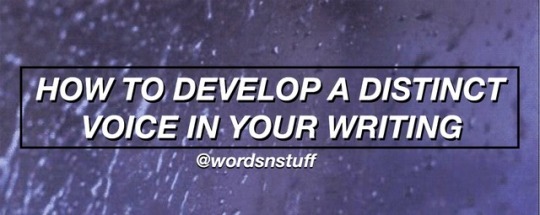
Voice in writing is extremely important and can make or break your story as a whole. It’s imperative that you pay attention to how readers interpret your writing voice because loving the author’s storytelling style can sometimes be just as important as the story itself. Here are some tips to remember and some general rules to follow in order to make sure your writing voice is enjoyable to listen to for your audience.
General Introduction & Some Things To Note
Voice is an audience’s ability to read something and know you wrote it. It’s essentially your fingerprint on your work.
The syntax is how an author chooses to order words in a sentence and can play a large role in conveying your voice.
Voice does not have to be yours alone, but more on that later.
How To Develop Your Voice
Rule 1: Write Naturally
Use voice as a tool, but don’t let it control you. Don’t try to force voice into your writing. Forcing voice can make it sound awkward and push the reader away.
Rule 2: Always Write For Clarity First
Be as clear as possible. Don’t embellish or use fancy words if unnecessary. If writing poetry, however, do the exact opposite.
Rule 3: Don’t Deviate Too Much From The Rules Of Writing
Doing this can alienate your readers. If you break the everyday rules too much and deviate from the technical conventions of writing, your readers may get distracted or lose track of what you’re trying to convey and what’s going on in the story as a whole.
Writing In Somebody Else’s Voice
A lot of authors choose to write stories from the point of view of a character in their story. Authors may also choose to write in a format that requires their voice to be that of someone who may be completely different than them. Being able to recognize small details that form a voice in your readers’ heads is very important, whether you’re telling them the story as yourself or through the eyes of another. Here are some tips on developing a voice that matches the point of view you are telling the story from:
Word Choice ~ Use words and phrases that are true to the character’s personality. If your character is a 21st-century teenager talking about some guy they’re “totally obsessed” with and want to “Netflix and Chill” with, then they probably won’t describe him as a “harrowing barbarian with golden flowing locks and a stone cold thirst for vengeance”.
Observation ~ Be careful when describing what your narrator observes throughout the story. If your narrator is supposed to be somewhat oblivious or gullible, they won’t notice the incredibly subtle mannerisms in everyone around them in order to conveniently draw conclusions and convey every piece of information the reader needs to predict the ending of the story.
Focus ~ Be mindful of what your narrator focuses on when describing a situation or the people around them. If your narrator chooses to point out that a character they don’t like happens to have the latest Rolex, this will hint at the reader that the character has a distaste for those with lots of wealth and therefore is somewhat of the opposite of the person they dislike. The things a person focuses on can tell you a lot about who they are and what they think of the world, and that is a massive deal when it comes to voice.
Descriptions ~ How your character describes the situations and minute details is important. Whether they say “shuddered” instead of “shook” or “steamed” instead of “angry” plays a large part in the reader getting to know your narrator.
Request a prompt list/writing advice/playlist/study help post here
4K notes
·
View notes
Text
NaNo Prep: Outline Your Story Like a Subway Map

We’re deep into NaNo Prep Season, and this week, we’ve asked participants to share their thoughts on how to craft great plots and build immersive worlds. Today, author and entrepreneur Gabriela Pereira shares her method of mapping out her story:
As a New Yorker born and raised, I think of an outline as being like a subway map. What I love about this approach is that it allows you to see how the various threads of your story work together, but you can also tease those elements apart and look at them individually to see how each thread holds up on its own.
When you make a subway map outline, each line represents a different subplot or story element you want to track. The dots (or stops) represent scenes in your story. Some scenes are like local stops on a subway and apply only to one story thread, while other scenes are like express stops and represent intersections between the story threads and mark key moments in your story. For an example of this technique in action, check out the subway map of Suzanne Collins’ The Hunger Games.
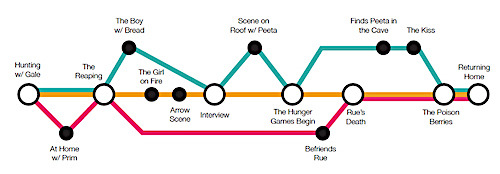
Want to learn how to put together a story map like this? Here’s a step-by-step guide.
Keep reading
7K notes
·
View notes
Photo
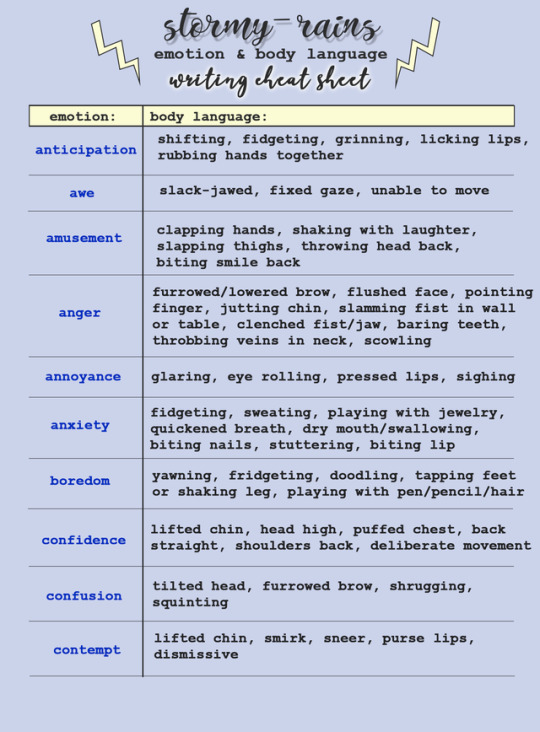
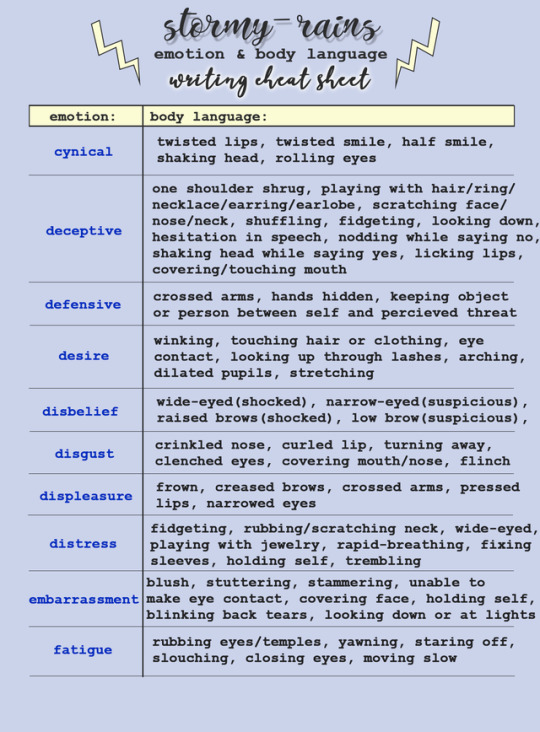
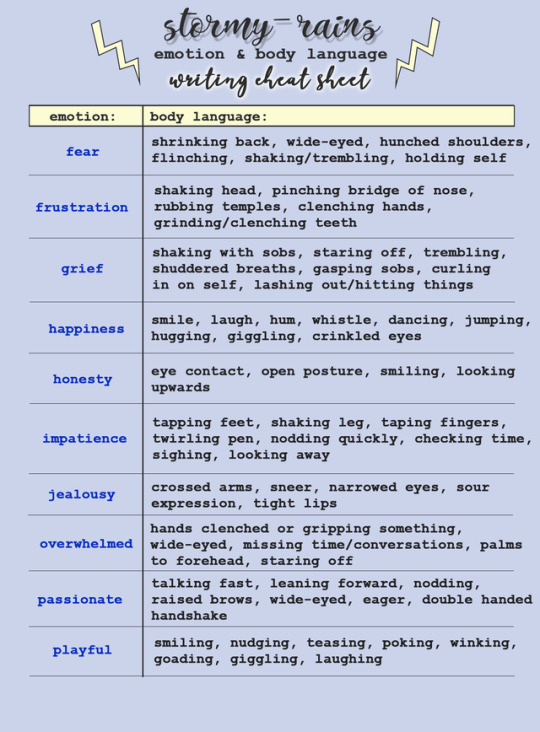

A Writing Cheat Sheet: for linking actions with emotions.
As always, click for HD.
53K notes
·
View notes
Text
Reblog the writers’ fortune cookie for luck!

257K notes
·
View notes
Quote
You're entitled to a voice so let me hear it
While She Sleeps - “SLEEPS SOCIETY“
#lyrics#lyric prompt#lyric starter#sentence#sentence starter#sentence prompt#quote#quote starter#quote prompt#motivation#inspiration#while she sleeps
0 notes
Quote
I don't know what hurts the most. Holding on or letting go.
Bring Me The Horizon - “1x1″
#lyrics#lyric prompt#lyric starter#quote#quote prompt#quote starter#sentence#sentence starter#sentence prompt#motivation#inspiration#bring me the horizon#bmth
12 notes
·
View notes
Text
Making a Murder: A Writer's Guide Special
Writers are found of murder, perhaps just as much as serial killers. Or maybe we are serial killers. Who knows. Murder can be one of the most familiar tools for a writer but in truth how much do we know about writing a murder? How many details can we get wrong without even knowing?
|Getting into the head of the Murderer|

When characters kill, it often helps to delve into the kind of mindset they have. As writers we strive for as much accuracy as possible. We could give Character A a gun and have them kill Character B, yes but is it accurate? Is Character B the kind of person Character A is motivated to kill? Is the weapon right? Is the situation wrong? We start by getting into the head of our killers.
To kill or not to kill
We begin as characters do. With the choice to kill or not to. When you watch police dramas or Netflix documentaries, you will hear the terms of "premeditated murder" or "crime of passion". These two categories are usually dictated by the character of the person committing it or the situation.
Premeditation means that the murder was planned. It can be boiled down to thinking about killing somebody to writing detailed plans with colours coded sticky-notes. You will find characters who are of a colder disposition landing in this category or perhaps someone seeking revenge. The killer often uses a pre-chosen weapon. Characters who pre-plan murders will likely lack empathy with their victim or have guilt about the crime. Example: The murder of Dumbledore.
Crime of passion is what it says on the tin. These murders happen within a split second when characters act out in a moment of emotional strain. Any character can act out and kill (by accident or intentionally) somebody. The killer will often use weapons of opportunity. These kinds of murders can lead to guilt in the perpetrator after the fact, letting the characters show empathy. Example: The death of Shae at the hands of Tryion Lannister.
Reasons To Kill
Motive is one of the most pressing subjects to touch on when one us profiling a killer in a novel. Motive fits the character and drives the actions. Financial gain, lust, defense and power are the top motives of the two sexes. But there are differences in the kind of killer a character is based on their gender. Women are most likely to fall into the motive categories of; Love, revenge, jealousy, financial gain, and concealment of a secret. Men fall into the categories of; revenge, financial gain, thrill of it, jealously.
Denoting Details
Details are no more important in this narrative than after the murder has taken place. Here we can glimpse into the psyche of the character and their true feelings for the victim. Here are some details:
A killer who mutilates a victim has little respect for the person and if the mutilation occurs in a private area, it can denote a sexual undertone.
A killer who covers a body is one who shows remorse or guilt or had respect for their victim's dignity.
A killer who chooses to place the body of their victim in a place of safety or importance is one that respects or cares for the victim and wants them to he found and cared for.
|Methods & Character|
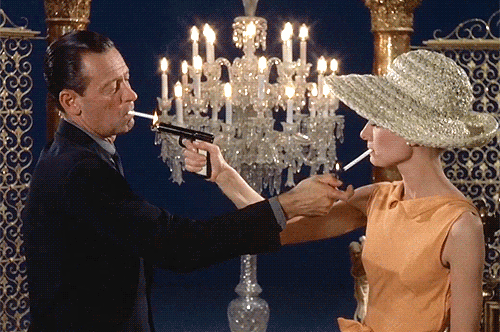
Method can be linked with the kind of person the character is. Crimes that occur using projectile weapons such as guns are seen to be more impersonal as the killer can be a distance away from the victim. It can show a detachment from the victim, usually a premeditated crime.
Murders caused by stabbing, beating or strangling often are used in crimes of passion because of the closeness between victim and murderer.
Battle of the Sexes


Studies find that men are more likely to kill using blunt objects, guns or their hands to murder. Women on the other hand rarely commit murder by using their hands, preferring weapons like knives, blunt objects and poison. Women tend to be reactive when murdering, often killing someone who had harmed them in some way and are less likely to kill strangers.
|The Meticulous Details|

The tiniest detail can lift a simple case of murder to one snacking of reality. By adding details to the narrative, you can ensure that you chose the right person/method.
Most killers who kill by stabbing, cut themselves in the process usually along the palms.
It takes 2-3 minutes for somebody to strangle the life from somebody.
No matter how careful your killer is, they will leave some kind of trace at the scene of the crime.
When firing a gun at close range, the killer will be splattered with blood. Every gun wielder will have trace of GSR (Gun shot residue) on their close or skin though it can be removed by soap and water.
Stranglings are intimate crimes.
A character who attacks their victim from behind is one who hasn't the stomach or the bravery to to face their victim.
Likewise a character who faces their victim is one that either knows their victim or has no qualms about doing what they are doing.
A killer who over-kills a victim, let's say stabs a victim over a hundred times when all it would take is one or two. It reveals that a character acted out of rage or perhaps fear, and that the victim was close to their killer.
It will take at least (approximately) 5 mins for somebody to bleed out.
A dead body begins a cycle of rigor mortis (muscles stiffening) 4-6 hours after death. Lividity (settling of the blood within the body) and decomposition where the fatty tissue of the body breaks down (this stages occurs 48-60 hours after death).
Certain drugs can effect the cycle of decomposition. Cocaine hastens rigor mortis while carbon monoxide can slow it down (as well as turn a body pink).
2K notes
·
View notes
Text
Wars, Battles and Sieges: Writing Your Battle (Your Notes)

Battles are to fantasy as stress is to writing. Battles can be the most exciting scenes to write as well as the toughest.
If you're an adrenaline writer, battles can be a rush. They flow from you as perfect as anything you've ever written... then comes editing.
If you're a meticulous writer who worries over every detail, writing a fast paced set of scenes will be torture for you.
So here are my tips to help you get through the slog of writing of a battle without giving yourself a coronary or wading through stacks of research.
When writing a battle you only need 3 sets of notes. You don't need mountains of paper in order to keep track of your battle, just these helpful notes.
Break it down

The best thing I ever discovered about writing battles (and this can be applied to any of your chapters btw) is to write them action by action. Make a list, beginning from the inciting moment and travel to the end. Writing the list helps you compile all the components together and gives you a clear view on what will be going down, with the charges and dramatic moments. For example, let's use the Battle of the Bastards.
The armies line up
Ramsay, dismounts and drags out Rickon on a rope. He tells Rickon to run, which he does.
Jon rides out to save him.
Rickon dies
Jon charges at Ramsay, Davos gives the
Bolton archers loose arrows, taking on Jon's horse, he falls
The Bolton cavalry charges at him, clashing with the Wildling-Northern forces.
Ramsay calls for more arrows but Davos stays his archers
The field begins to get crowded, bodies piling up. The warriors struggle on the uneven ground. It gets messy.
Davos charges in with the rest of the Northern forces
Ramsay gives the order for encirclement. His soldiers close in, blocking the Northern forces off from escaping. They begin closing in, crushing them.
A horn blows in the distance. The Arryn forces come up from the rear, crash into the Bolton lines, destroying them.
Maps
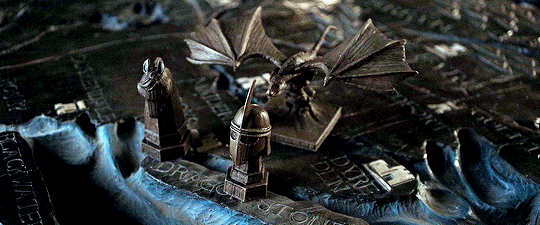
Drawing out your field of battlefield can be a help. Having a picture in front of you can help you visualize the field. Drawing out the alignment of your army (where the cavalry will be, where your infantry are, who is standing where) as well as the geographical features of the field, help you keep track of where everything is.
Keeping track of Injuries

The trickiest part of battles for me is keeping tabs on the injuries characters sustain during the battle. This is more a catch after the battle for me but injuries can effect the actions of your characters. During a major battle in TTK I wrote recently, I found that I couldn't recall all the wounds I inflicted on my characters when writing their recovery scenes which meant I had to comb through the battle scene to find those details. Writing lists of character injuries can seem tedious but it can give you a template for your action by action list.
470 notes
·
View notes
Text
Anyone that says the first cut is the deepest didn’t stick around for the second one.
#orignial#original writing#original quote#writing#writing prompt#writing starter#sentence#sentence prompt#sentence starter#motivation#inspiration#writing motivation#writing inspiration
2 notes
·
View notes
Text
PSA: Artists, Don’t Give Up!
As someone that tries to be creative/create things myself, I understand how hard it can be to actually do it.
No matter what your craft is, getting that perfect scene, piece of dialogue, next hit song, or timeless statue out of your headspace and into your hands can feel like one the most difficult task on earth.
Please remember to take your time and enjoy what you’re doing. We’re our own worst critics and it’s easy to devalue your own amazing work. Don’t let yourself be the reason you stop doing something you love!
We’re all inspired by something and it’s okay to take a step back and remember what that something is. It’s even okay to lose that inspiration. Ideas come and go but the love of your craft will last a lifetime and then some.
We all create for our own motives but art, and creation, has the unique ability to touch the minds and souls of others.
#self care#motivation#inspiration#life tip#writing tip#art tip#creation#dont give up#psa#public service announcement
34 notes
·
View notes
Quote
We're on the clock and the needle is turning fast
PERIPHERY - “Marigold“
#lyrics#lyrics prompt#lyrics inspiration#motivation#inspiration#writing#writing prompt#writing starter#sentence#sentence starter#sentence prompt#periphery
4 notes
·
View notes
Quote
The emptiness is heavier than you think
Bring Me The Horizon - “Teardrops”
#lyrics#lyrics prompt#lyrics motivation#writing#writing prompt#writing motivation#writing inspiration#motivation#inspiration#sentence#sentence prompt#sentence starter#bring me the horizon#bmth
175 notes
·
View notes
Text
How to Format Your Finished Manuscript
as written by a perpetually flabbergasted editor
Congratulations, you’ve finished a manuscript! That monumental achievement alone deserves a reward. Please get yourself something delicious—don’t worry, I can wait.
Back? Awesome, because it’s time to talk about an important step of the prepublishing and/or pre-editing process, and that is how to format your manuscript.
When you’re writing your manuscript, it’s likely you have a unique setup. Fancy fonts, different text and document background colors, your preferred way of formatting the document—all elements work together to create a comfortable writing space where you can be your most creative.
As both a writer and editor, I have no problems with writers going wild with their documents’ technical aspects while they’re drafting—I do exactly the same thing when drafting. But when it comes time to share your project with other people—especially professionals in the publishing world—your snazzy setup is no longer going to be a benefit. I could share horror stories relating to document setup, from thousands of spaces used instead of the tab key to wacky file conversion issues.
Please don’t make your editor’s job any harder than it needs to be. Fancy formatting looks great, but it can be a nightmare to undo and wastes time that your editor could otherwise spend polishing the words themselves rather than what’s around them. It’s also significantly easier to work with a document that adheres to a standard format because it’s easier to catch mistakes that way—the editor isn’t distracted trying to wrangle extra spaces and text appearing in other languages.
Most publishing houses have what are called submission guidelines. Read them. Follow them. There’s little chance your manuscript is exempt from the rules, and believe me when I say authors who flaunt the guidelines don’t win the respect of the people who are working on their manuscripts.
If the publisher/editing service you’re submitting to doesn’t have obvious guidelines, first ask about them. They might have preferences. If not, as follows are some basic standard practices in North American publishing.
First off, if you can’t bear to give up your fancy writing setup, create a new copy of your document specifically for editing/submitting. Clearly label it as such. Make sure you implement any changes to this for-editing/submitting document, not just your fancy original.
Page and text setup:
Remove any document background images/page colors.
Change the entire document’s font to Times New Roman point 12. Make it black. Not dark gray, not dark brown—black.
Set the margins to one inch on all sides. This is Microsoft Word’s default document format, but not enough submitted manuscripts use it. Remember: layout for publishing comes after editing, not before. Editors are liable to completely change your document’s pretty formatting to industry standards anyway.
Set the document’s orientation to portrait, not landscape.
Center all section and chapter titles (e.g., Table of Contents, Chapter 1, Acknowledgements, About the Author, etc.).
Remove all double spaces from the file. Seriously. This is an incredibly easy step. Do not make your overworked, underpaid editor do this incredibly trivial and time-consuming task for you. Especially if you are using double spaces to indent or center content. If you, for some reason, are using the space bar to indent or center content, please stop what you are doing and follow these steps:
Use your word processor’s “center text” function. In programs like Word, this can be done by hitting Control + E. (Ctrl + L and Ctrl + R, respectively, align text left and right.) Do not justify your text unless the guidelines demand it.
Use the tab key to indent paragraphs.
But bear in mind that sometimes this can result in a “tab” character existing at the beginning of a paragraph. This is bad. Preferably, set the entire document to a 0.5-inch indent and delete all tab characters.
Seriously, though, you should be searching every document before you send it out or copy it to an online format for double spaces. Make this a good habit, and you’ll ensure you set yourself apart as a cut above the other writers out there.
Set the entire document’s line spacing to double.
Front matter, chapters, and back matter should be separated by page breaks, not by a series of blank lines.
If you really want to delight your editor or anyone else who needs to work on your manuscript, consider removing all leading and trailing spaces from the document (link embedded).
Style elements:
Run spell check. This sounds obvious, but trust me, I’ve received manuscripts riddled with obvious spelling errors. If you write with spell check off for one reason or another, turn it back on when you’re getting ready to send a document out. Make a full pass on the document, and pay attention to every instance of that red squiggle.
Make sure you’re spelling the names of your characters and places consistently. I’ve seen Matt become Mike in the next paragraph, and Donilo become Donillo. Editors’ trust in the author’s abilities to do anything with competence drop drastically when we find these kinds of careless errors.
Similarly, either use the American spellings or the British spellings. Be consistent.
Separate your scenes with fleuron breaks. Three centered asterisks (***) used without spaces is the most common method of creating a fleuron break and the one I recommend using, although sometimes three number signs/hashes (###) can be acceptable. Do not use fancy symbols or symbols created through special fonts. They will not carry through if your editor changes your entire document to Times New Roman.
Optional change: remove the indent from the first paragraph in a chapter or after a scene break.
Make a point of using punctuation consistently. If you’re going to use the oxford comma, use it every time. Use a single dash consistently. Punctuate dialogue properly.
Improperly punctuated dialogue is one of the most common errors editors fix. There are only a few basic rules, covered here (link embedded), so please make an effort to learn and use them.
Use paragraphs properly. New speaker = new paragraph. New subject = new paragraph.
Once again, if you really want to delight your editor, change all hyphens between number ranges to en dashes. 3-5 days will become 3–5 days.
Correctly title your document. The title isn’t somehow going to magically change from StupidProject.docx or afhuowjfoa;wijef.docx to TheHungerGames.docx between your submitting it and other people reading the title.
If possible, use the .docx file format.
I want to wrap this up by saying that yes, editors are here to catch the mistakes you’ve missed, and we invariably have obscure technical knowledge that most writers don’t know exists (in Greek, the question mark is represented by a semicolon), but it’s your job as the writer to put your best effort forward. Also bear in mind that not all editors get paid to handle formatting issues but are expected to resolve them anyway. Fixing these basic issues yourself or, better yet, not creating them at all will help both you and your editor(s) ensure the version of the book you put out is the best possible version.
2K notes
·
View notes
Text
Apps I use/used to improve my English
Duolingo: does this one even need explaining? It’s great for learning the basics of a language, so it’s a good one if you’re just starting out.
Memrise: this is an app my university used for vocabulary lists, you can make your own lists or use existing ones. The lists often work with explanations instead of translations. It also has sound clips of how words are pronounced. You learn through different exercises that go from easy to harder depending on how well you know the word. You’ll learn new words in fives and can refresh words you learned previously. I personally really like this app and still use it.
Elevate: This one doesn’t specifically focus on learning English, but more on elevating certain language and math skills. In the free version (I ain’t paying for shit) you can do daily training where you get 3 different exercises. Some examples are punctuation, brevity (what words can you leave out), spelling, reading comprehension,… For math some examples are division, estimation, discounting,… So this is more for improving when you’re already at a certain level. I personally like the diversity you get with all the different exercises and still use this.
488 notes
·
View notes
Text
from last year’s workshop: Cool Writing Hacks that ripped my heart out but made my work better anyway.
-not every line of dialog needs an action attached to it. somebody doesn’t need to shrug or scratch their arm or glance at other people every two seconds of a conversation unless the motion means something. you’re not writing stage directions and you can trim this stuff down to make your dialog snappier. (this one in particular felt like a callout of me specifically, goddammit)
-if you want the audience to remember something–especially something that will be important in a climactic moment–you have to show/tell them at least twice beforehand. preferably three times. otherwise they will not remember! they simply will not!!
-the room layout isn’t usually all that important BUT if there’s going to be a fight scene you BETTER fucking figure out a way to convey that entire layout early in the scene or no one will know what the fuck is going on
-on that note, get somebody to read your fight scenes even if you are ABSOLUTELY SURE they make sense on the page. on the first pass they probably don’t. (unless you have a gift i would kill for. some do!)
-eyes cannot talk. eyes can’t talk! it’s easy to say that someone has “rage in their eyes” or “their eyes were telling me to run” but that’s all shorthand for other body language we notice subconsciously! try digging in and describing that body language instead. you will likely get something richer that way
7K notes
·
View notes
Photo
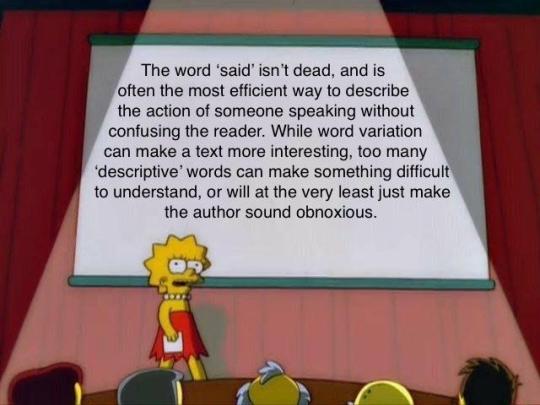
to all my writer friends out there.
50K notes
·
View notes
Text
Words to describe someone’s voice :
adenoidal (adj) : some of the sound seems to come through their nose.
appealing (adj): voice shows that you want help, approval, or agreement.
breathy (adj): with loud breathing noises.
booming (adj): very loud and attention-getting.
brittle (adj): if you speak in a brittle voice, you sound as if you are about to cry.
croaky (adj): they speak in a low, rough voice that sounds as if they have a sore throat.
grating (adj): a grating voice, laugh, or sound is unpleasant and annoying.
gravelly (adj): a gravelly voice sounds low and rough.
high-pitched (adj): true to its name, a high-pitched voice or sound is very high.
honeyed (adj): honeyed words or a honeyed voice sound very nice, but you cannot trust the person who is speaking.
matter-of-fact (adj): usually used if the person speaking knows what they are talking about (or absolutely think they know what they are talking about).
penetrating (adj): a penetrating voice is so high or loud that it makes you slightly uncomfortable.
raucous (adj): a raucous voice or noise is loud and sounds rough.
rough (adj): a rough voice is not soft and is unpleasant to listen to.
shrill (adj): a shrill voice is very loud, high, and unpleasant.
silvery (adj): this voice is clear, light, and pleasant.
stentorian (adj): a stentorian voice sounds very loud and severe.
strangled (adj): a strangled sound is one that someone stops before they finish making it.
strident (adj): this voice is loud and unpleasant.
thick (adj): if your voice is thick with an emotion, it sounds less clear than usual because of the emotion.
tight (adj): shows that you are nervous or annoyed.
toneless (adj): does not express any emotion.
wheezy (adj): a wheezy noise sounds as if it is made by someone who has difficulty breathing.
29K notes
·
View notes